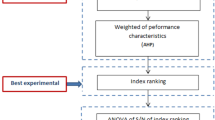Abstract
Electrical discharge machining (EDM) is now a widely adopted subtractive manufacturing process to shape titanium and its alloys to obtain desired profile and surface integrity. Predicting and optimizing the process behavior is the need of today’s manufacturing paradigm. Many new and better optimization algorithms have came into existence in the recent past to extract best out of any manufacturing processes. In this paper, EDM has been carried out on Ti–6Al–4 V alloy by varying important electrical parameters to estimate the two of the major performances i.e. material removal rate (MRR) and tool wear rate (TWR). Second-order regression equation using statistical analysis has been obtained for both the performances. Single objective optimization has been done using four evolutionary optimization algorithms. All the four algorithms have been compared for their performances in the present research environment.






Similar content being viewed by others
References
Deb K (2010) Optimization for engineering design algorithms. PHI, Inc.
He S, Prempain E, Wu QH (2004) An improved particle swarm optimization for mechanical design optimization problems. Eng Optim 36(5):585–605
Huang VL, Qin AK, Suganthan PN (2006) Self-adaptive differential evolution algorithm for constrained real-parameter optimization. In: IEEE Congress on Evolutionary Computation (CEC), pp.17–24.
Jaber E, Abu Q et al (2018) Electric discharge machining of titanium and its alloys: review. I J Adv Manuf Technol 96(1):1319–1339
Kennedy J, Eberhart R (1995) Particle swarm optimization. Proc IEEE Int Conf Neural Netw (ICNN 95) 4:1942–1948
Khan MAR, Rahman M, Kadirgama K (2014) Neural network modeling and analysis for surface characteristics in electrical discharge machining. Procedia Eng 90:631–636
Kreyszig EW (2001) Advance engineering mathematics. Wiley.
Kumar S et al (2014) A hybrid Taguchi artificial neural network approach to predict surface roughness during electric discharge machining of titanium alloys. J Mech Sci Technology 28(7):2831–2844
Kumar S et al (2016) Machining performance of cryogenically treated Ti–5Al–2.5Sn titanium alloy in electric discharge machining: a comparative study. Proc IMechE, Part C J Mech Eng Sci. https://doi.org/10.1177/0954406215628030
Kuriakose S, Shunmugam M (2005) Multi-objective optimization of wire-electro discharge machining process by non-dominated sorting genetic algorithm. J Mater Process Technol 170(1):133–141
Mallipeddi R, Suganthan PN (2011) Ensemble differential evolution algorithm for CEC2011 problems. In: IEEE Congress on Evolutionary Computation (CEC), pp.1557–1564.
Manjaiah M et al (2014) Wire electric discharge machining characteristics of titanium nickel shape memory alloy. Trans Nonferrous Metals Soc China 24(10):3201–3209
Raj SON, Prabhu S (2017) Analysis of multi objective optimisation using TOPSIS method in EDM process with CNT infused copper electrode. Int J Mach Mach Mater. https://doi.org/10.1504/IJMMM.2017.081190
Rangajanardhaa G, Rao S (2009) Development of hybrid model and optimization of surface roughness in electric discharge machining using artificial neural networks and genetic algorithm. J Mater Process Technol 209(3):1512–1520
Rao RV, Savsani VJ, Vakharia DP (2012) Teaching-learning-based optimization: an optimization method for continuous non-linear large scale problems. Inf Sci 183:1–15
Roy T, Dutta RK (2019) Integrated fuzzy AHP and fuzzy TOPSIS methods for multi-objective optimization of electro discharge machining process. Soft Comput 23:5053–5063
Sahu SN, Nayak NC (2018) Multi-objective optimisation of EDM process using ANN integrated with NSGA-II algorithm. Int J Mach Machina Mater. https://doi.org/10.1504/IJMTM.2018.093356
Sarkar S et al (2005) Parametric analysis and optimization of wire electrical discharge machining of γ-titanium aluminide alloy. J Mater Process Technol 159(3):286–294
Sarkar S, Mitra S, Bhattacharyya B (2006) Parametric optimization of wire electrical discharge machining of γ titanium aluminide alloy through an artificial neural network model. Int J Adv Manuf Technology 27:501–508
Sarkar S et al (2008) Modeling and optimization of wire electrical discharge machining of γ-TiAl in trim cutting operation. J Mater Process Technol 205(1):376–387
Shrivastava PK, Dubey AK (2015) Study of electrical discharge abrasive grinding process performance using CBN abrasive. Int J Abrasive Technol 7(2):90–106
Shrivastava PK, Dubey AK (2016) Modelling and multi-objective optimisation of EDDG process using hybrid ANN-GA approach. In J Abrasive Technol 7(3):226–245
Titare LS, Singh P, Arya LD, Choube SC (2014) Optimal reactive power rescheduling based on EPSDE algorithm to enhance static voltage stability. I J Elect Power Energy Syst 63:588–599
Tsukahara H et al (1999) Surface modification of titanium using EDM process. J Jpn Soc Electr Mach Eng 33(74):9–15
Venkatarao K, Kumar AT (2019) An experimental parametric analysis on performance characteristics in wire electric discharge machining of Inconel 718. Proc IMechE Part C. https://doi.org/10.1177/0954406219840677
Funding
This research received no specific Grant from any funding agency in the public, commercial, or not-for-profit sectors.
Author information
Authors and Affiliations
Corresponding author
Ethics declarations
Conflict of interest
The authors declare that there is no conflict of interest.
Additional information
Publisher's Note
Springer Nature remains neutral with regard to jurisdictional claims in published maps and institutional affiliations.
Rights and permissions
About this article
Cite this article
Singh, M.R., Shrivastava, P.K. & Singh, P. Optimization of EDM process of titanium alloy using EPSDE technique. Multiscale and Multidiscip. Model. Exp. and Des. 4, 121–130 (2021). https://doi.org/10.1007/s41939-020-00084-0
Received:
Accepted:
Published:
Issue Date:
DOI: https://doi.org/10.1007/s41939-020-00084-0




